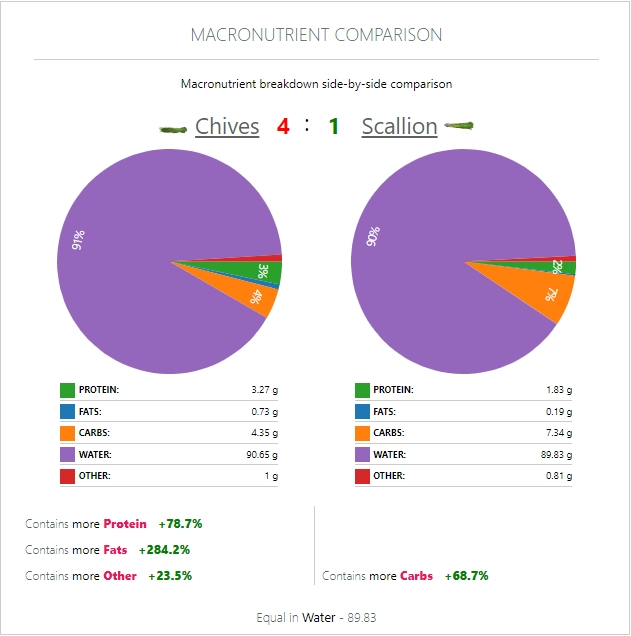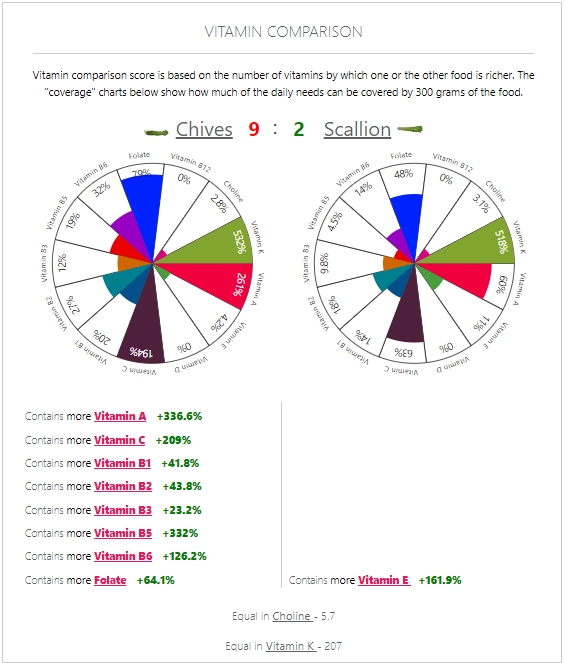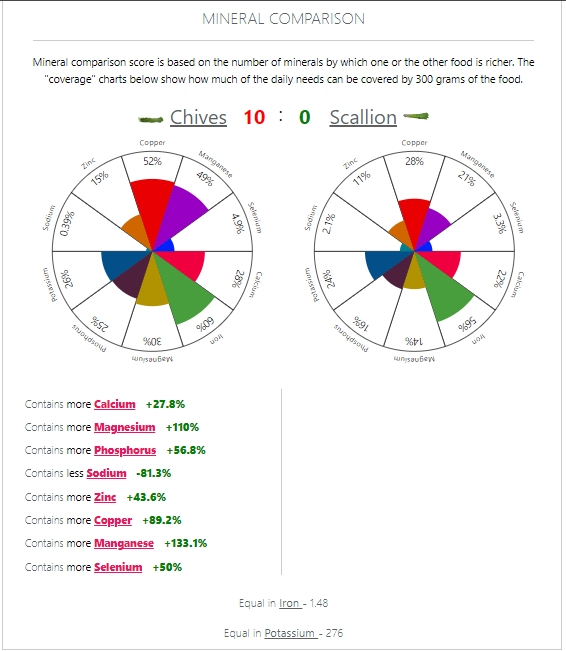Chives vs. Scallion — What’s the Difference? Health, Nutrition, & More
Summary
Chives are richer in key nutrients, including vitamins C, A, folate, manganese, copper, B6, and magnesium. Specifically, chives provide 44% more daily vitamin C coverage than scallions. However, chives contain four times more vitamin A RAE, with 218µg compared to scallions' 50µg.
Chives have a slender, tubular green stem and a mid-onion-like flavor, while scallions (green onions) have a more pronounced structure with a crisp white base and hollow green tops and offer a slightly stronger onion flavor. Scallions have white bulbs, which chives do not have.
Table of contents
Introduction
We will compare raw chives and raw scallions (green onions), focusing on their nutritional and health benefits.
Nutrition
The nutritional values below are shown for raw chives and raw scallions. These foods will be compared based on their nutritional content in 100g servings.
Macronutrients and Calories

Both chives and scallions contain 90% water. The average serving size of chives is 1 tsp chopped, equal to 1 gram.
Scollions have a similar average serving size of one tablespoon, equal to 6 g of scollions.
Calories
A 100g serving of chives provides 30 calories, whereas the same serving size of scallions contains 32 calories.
Protein and Fats
Chives are richer in both protein and fat. Chives are also higher in all essential amino acids than scallions. They contain 3.27 grams of protein compared to 1.83 grams of scallions. Regarding fat, chives have 0.73 grams, while scallions have 0.19 grams.
The predominant fat types found in these herbs are saturated and polyunsaturated fats.
Carbohydrates
Scallions contain almost 1.6 times more carbohydrates than chives. Although the two herbs contain similar amounts of fiber, scallions contain 2.5 times more net carbs.
Vitamins
Chives provide a higher level of a few more vitamins.
Chives contain almost three times more vitamin C, four times more vitamin A and vitamin B5, over two times more vitamin B6, 1.6 times more folate, and 1.4 times more vitamin B2. Additionally, chives contain more vitamin B1 (0.078 mg vs. 0.055 mg), vitamin B3 (0.647 mg vs. 0.525 mg), and vitamin K (212.7 µg vs. 207 µg).
On the other hand, scallions provide more vitamin E and choline.

Minerals
Chives provide two times more magnesium, manganese, and copper and 1.5 times more phosphorus. Compared to scallions, they also contain higher amounts of calcium (92 mg vs. 72 mg), iron (1.6 mg vs. 1.48 mg), potassium (296 mg vs. 276 mg), zinc (0.56 mg vs. 0.39 mg), and selenium (0.9 µg vs. 0.6 µg).

Oxalates
The oxalate content of chives is 25 mg per 100 grams.
The oxalate content of scallions is 7 mg per 100 grams. They both contain low levels of oxalates.
Glycemic Index
Chives and scallions are considered low-GI foods but differ slightly in their glycemic index (GI). The GI of Chives is 45, while the GI of scallions is 32.
Acidity
Both chives and scallions are alkaline-forming foods. Chives have a PRAL value of -4.8, while scallions have a slightly higher alkaline PRAL value of -5. This means both vegetables contribute to reducing acidity in the body, promoting an alkaline environment, which is beneficial for overall health.
Health Benefits
Cardiovascular Health and Diabetes
Chives are particularly potent due to their low glycemic index and minimal carbohydrate content, making them excellent for stabilizing blood sugar levels. They contain allicin, which reduces bad cholesterol and blood pressure by promoting nitric oxide release, and quercetin, which prevents arterial plaque and lowers stroke risk (1, 2). On the other hand, scallions provide about 10% of the daily fiber requirement per cup, aiding in cholesterol reduction and blood sugar regulation (3).
Anti-inflammatory Effects
Both chives and scallions (spring onions) are potent anti-inflammatory and antioxidant foods, offering significant health benefits. Antioxidants like vitamin C and quercetin, which lessen oxidative stress and protect against cell damage, are only a few anti-inflammatory substances in chives (4, 5). They also boost circulation and strengthen the immune system. Scallions, conversely, contain essential amino acids that promote healthy skin by reducing redness and swelling. Their high flavonoid content combats free radical damage, reduces acne and scars, and minimizes skin irritation (6).
Digestive Health
Scallions are rich in natural fibers that take longer to digest, helping to regulate appetite and curb cravings for unhealthy foods. They also aid in lipid metabolism and reduce starch and sugar levels in the body (7). On the other hand, chives are packed with vitamins B1, B2, and B3 and dietary fiber, which work together to enhance the metabolism of carbohydrates, proteins, and fats, regulate appetite, and support smooth digestion (8, 9).
Cancer
Like other alliums, scallions contain allicin, a compound believed to prevent cells from becoming cancerous and slow tumor growth, particularly in the stomach (10). Allicin is responsible for the strong flavor of these vegetables and is thought to play a key role in blocking cancer cell proliferation (11).
On the other hand, chives are rich in lutein and zeaxanthin, two flavonoid antioxidants that are effective in fighting mouth and lung cancers (12, 13).
Downsides and Risks
Both scallions and chives can induce allergic responses in certain people, especially those sensitive to Allium plants like onions, garlic, and leeks. Allergic reactions may manifest as itching, skin rashes, swelling, or gastrointestinal distress. In more severe cases, symptoms could include difficulty breathing, hives, and anaphylaxis, which require immediate medical attention (14). Individuals with known allergies to these plants should avoid consuming scallions and chives and be mindful of their presence in various dishes.
Actual Differences
Chives are typically used raw as a garnish to add elegance to dishes. They have a pronounced grassy onion flavor and are associated with herbs like parsley and basil rather than being considered vegetables. Chives are harvested by cutting the green stems, allowing regrowth, whereas scallions are typically harvested young before a bulb forms, with both the white base and green tops being edible.
Culinary Uses
Scallions and chives, both part of the allium genus, are versatile ingredients in various recipes. Chives are primarily used raw to garnish and enhance dishes with their delicate, onion-like flavor and vibrant green color, perfect for omelets, soups, salads, baked potatoes, and egg dishes. They are also mixed into herb butter and cream cheese for a subtle flavor infusion. To add complexity, fresh chives can also be included in dips and dressings. Scallions offer more versatility when used raw and cooked. Their crisp texture and strong flavor make them suitable for salads (potato salad), stir-fries, sautés, soups, sauces, and marinades. The white base of scallions is often cooked for a more intense flavor, while the green tops are added raw or towards the end of cooking for a fresh, colorful finish.
It’s optimal to store these ingredients in the refrigerator to keep them fresh for as long as possible.
Varieties
Chives (Allium schoenoprasum) come in several varieties, including the onion chives, which are widely used for their slender, tubular green stems and mild onion flavor; garlic chives (Allium tuberosum), known for their flat leaves and subtle garlic taste, often used in Asian cuisine; and giant Siberian chives, which are larger and more robust with a stronger flavor, ideal for adding a more intense onion taste. Scallions (Allium fistulosum) also have notable varieties, such as Evergreen Long White Bunching, which features long white stalks and is resistant to bulbing; Tokyo Long White, a Japanese variety with long white stems and dark green tops; White Lisbon, known for its fast growth and mild flavor; Parade, which offers uniform white stalks and bright green tops; and Red Beard, characterized by its reddish-purple base and stronger flavor, adding visual appeal and depth to dishes.
Sources
- https://www.ncbi.nlm.nih.gov/pmc/articles/PMC5136635/
- https://www.ncbi.nlm.nih.gov/pmc/articles/PMC10694509/
- https://pubmed.ncbi.nlm.nih.gov/31126110/
- https://pubmed.ncbi.nlm.nih.gov/7844109/
- https://pubmed.ncbi.nlm.nih.gov/37513932/
- https://www.ncbi.nlm.nih.gov/pmc/articles/PMC7919894/
- https://pubmed.ncbi.nlm.nih.gov/36193993/
- https://pubmed.ncbi.nlm.nih.gov/30074168/
- https://www.ncbi.nlm.nih.gov/pmc/articles/PMC9664698/
- https://pubmed.ncbi.nlm.nih.gov/36789941/
- https://www.sciencedirect.com/science/article/abs/
- https://pubmed.ncbi.nlm.nih.gov/35653117/
- https://www.mdpi.com/1996-1944/14/11/2968/
- https://www.ncbi.nlm.nih.gov/pmc/articles/PMC8452398/
